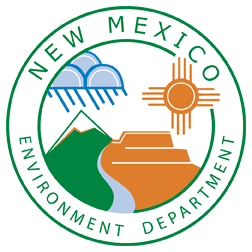Pet Dogs on Outdoor Patios
Pet dogs may be allowed on outdoor patios under certain circumstances and restrictions. Please see 6-501.115(6) in the Field Guide for further details.
As stated in this section, signage approved by NMED-EHB is required. You are welcome to create your own sign and submit it to your local field office for approval, or you may use this sign that is “pre-approved”.
If you have further questions concerning the regulations or the comment process please email or call us at: food.program@state.nm.us or (505) 222-9500.
| Regulatory |
| What kind of permit(s) do I need to sell burritos I make in my home kitchen? What are the requirements for a mobile food service establishment? |
| Facilities |
| Does a small restaurant or mobile unit need to have commercial equipment? Will the Environment Department come out to look at a building and tell me if it’s suitable for a restaurant? |
| Safety |
| What is a food borne illness? What is a potentially hazardous food (AKA Time and temperature control for safety)? What is ready-to-eat food? When should food handlers use gloves in food preparation? When should food handlers wash their hands? What is cross contamination? |
| Training |
| Is there food safety training available for myself or my staff? |
| Alerts |
| What are alerts? |
| What kind of permit(s) do I need to sell burritos I make in my home kitchen? That’s actually a trick question. Food prepared under a home-based food processing permit cannot be “potentially hazardous food,” which means it must be food that does not required time or temperature control for safety (see definition below in another question). Since burritos require being held at an appropriate temperature to limit pathogenic microorganism growth or toxin formation, they can only be prepared in a permitted commercial kitchen or under a temporary food establishment permit at a fixed location in conjunction with a single event or celebration. All food service establishments are required to have a food service permit. However, New Mexico requires complete separation between food service operations and domestic facilities. In other words, to have a food service establishment (other than a home-based food processing operation) in a private home requires a separate kitchen. There may be local zoning issues to consider also. For further information see also: Food Regulations, Home-based Food Processing back to top |
| What are the requirements for a mobile food service establishment? The requirements are the same as for other restaurants, except self-contained mobile units are not required to have on-board restroom facilities for employees. The requirements are contained in the New Mexico Food Service and Food Processing Regulations. The Plan Review Guidelines are a useful guide to planning your business operations and facilities. back to top |
| Does a small restaurant or mobile unit need to have commercial equipment? Generally, all major equipment such as refrigerators, stoves, dish machines, etc., must be ANSI-Certified. back to top |
| Will the Environment Department come out to look at a building and tell me if it’s suitable for a restaurant? You will include facility information in the initial plan review stage. As shown in the Plan Review Guidelines, information should include a floor plan, plumbing details, finish information, and other relevant information. A letter of plan approval should be obtained prior to beginning construction. A pre-opening inspection is required when most construction is complete and equipment is in place. back to top |
| What is a food borne illness? Diseases caused by ingestion of contaminated food. The contamination can be bacteria, viruses, parasites, and natural man-made chemicals. back to top |
| What is a potentially hazardous food (AKA Time and temperature control for safety TCS)? A potentially hazardous food or PHF is a moist, high protein food on which bacteria can grow most easily. Some examples are dairy products, shelled eggs, meats, poultry, fish, shellfish, heat-treated vegetables (i.e. potatoes, beans, rice, etc.), soy products, oil in garlic, sliced fruits, and raw sprouts (AKA Time and temperature control for safety TCS). back to top |
| What is a ready-to-eat food? A ready-to-eat food or RTE is any food that will be served to a consumer without a further pathogenic reduction step (cooking, washing, etc.). RTE’s include properly cooked potentially hazardous foods, washed whole or cut fruits and vegetables, and food products removed from their packaging, etc. back to top |
| When should food handlers use gloves in food preparation? Gloves or other physical barriers such as spatulas, tongs, bakery paper, etc. should be used when handling ready-to-eat foods. A ready-to-eat food or RTE is any food that will be served to a consumer without a further pathogenic reduction step (cooking, washing, etc.). RTE’s include properly cooked potentially hazardous foods, washed whole or cut fruits and vegetables, and food products removed from their packaging, etc. back to top |
| When should food handlers wash their hands? Food handlers should wash their hands before starting work and after an activity that may have contaminated their hands. Proper hand hygiene is an effective way to prevent the contamination of food that may cause food borne illness. Gloves or other physical barriers such as spatulas, tongs, bakery paper, etc. should be used when handling ready-to-eat foods. A ready-to-eat food or RTE is any food that will be served to a consumer without a further pathogenic reduction step (cooking, washing, etc.). RTE’s include properly cooked potentially hazardous foods, washed whole or cut fruits and vegetables, and food products removed from their packaging, etc. back to top |
| What is cross-contamination? Cross-contamination is the transfer of harmful substances or disease-causing microorganisms to food. The contamination can be caused by food contact with improperly washed hands and dirty food-contact surfaces, bare hand contact of ready-to-eat foods, contact of raw meats with ready-to-eat-foods, etc. Food handlers should wash their hands before starting work and after an activity that may have contaminated their hands. Proper hand hygiene is an effective way to prevent the contamination of food that may cause food borne illness. Gloves or other physical barriers such as spatulas, tongs, bakery paper, etc. should be used when handling ready-to-eat foods .A ready-to-eat food or RTE is any food that will be served to a consumer without a further pathogenic reduction step (cooking, washing, etc.). RTE’s include properly cooked potentially hazardous foods, washed whole or cut fruits and vegetables, and food products removed from their packaging, etc. back to top |
| Is there food safety training available for myself or my staff? Information for available trainings can be found under the Resources menu tab. back to top |
| What are alerts? Alerts inform consumers of certain problems associated with food and, in some cases, provide details of specific action to be taken. NMED inspectors keep a watchful eye on nationwide food safety issues such as: product recalls, trace backs, etc. “Alerts” are updated often so keep this link under your “Favorites” . For further information see also: Food Alerts |

